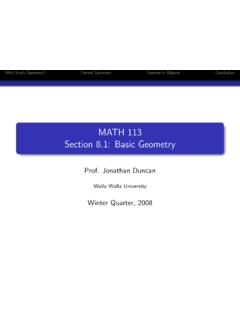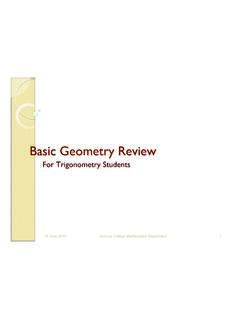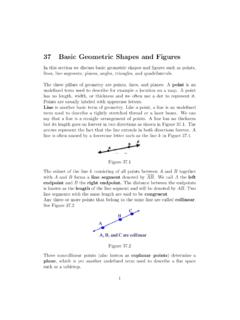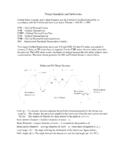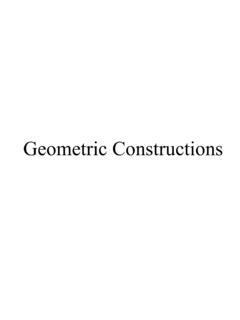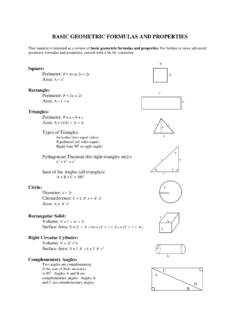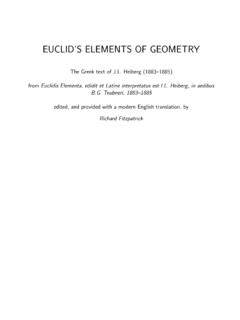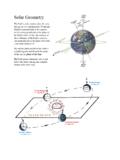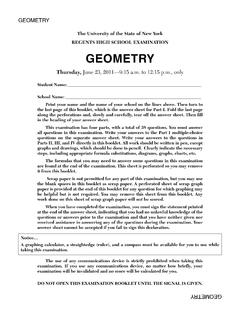Transcription of Geometry Vocabulary Cards
1 virginia department of education 2013 Geometry Vocabulary Cards Page 1 High School Mathematics Geometry Vocabulary Word Wall Cards Table of Contents Reasoning, Lines, and Transformations Basics of Geometry 1 Basics of Geometry 2 Geometry Notation Logic Notation Set Notation Conditional Statement Converse Inverse Contrapositive Symbolic Representations Deductive Reasoning Inductive Reasoning Proof Properties of Congruence Law of Detachment Law of Syllogism Counterexample Perpendicular Lines Parallel Lines Skew Lines Transversal Corresponding Angles Alternate Interior Angles Alternate Exterior Angles Consecutive Interior Angles Parallel Lines Midpoint Midpoint Formula Slope Formula Slope of Lines in Coordinate
2 Plane Distance Formula Line Symmetry Point Symmetry Rotation (Origin) Reflection Translation Dilation Rotation (Point) Perpendicular Bisector Constructions: o A line segment congruent to a given line segment o Perpendicular bisector of a line segment o A perpendicular to a given line from a point not on the line o A perpendicular to a given line at a point on the line o A bisector of an angle o An angle congruent to a given angle o A line parallel to a given line through a point not on the given line o An equilateral triangle inscribed in a circle o A square inscribed in a circle o A regular hexagon inscribed in a circle o An inscribed circle of a triangle o A circumscribed circle of a triangle
3 virginia department of education 2013 Geometry Vocabulary Cards Page 2 o A tangent line from a point outside a given circle to the circle Triangles Classifying Triangles by Sides Classifying Triangles by Angles Triangle Sum Theorem Exterior Angle Theorem Pythagorean Theorem Angle and Sides Relationships Triangle Inequality Theorem Congruent Triangles SSS Triangle Congruence Postulate SAS Triangle Congruence Postulate HL Right Triangle Congruence ASA Triangle Congruence Postulate AAS Triangle Congruence Theorem Similar Polygons Similar Triangles and Proportions AA Triangle Similarity Postulate SAS Triangle Similarity Theorem SSS Triangle Similarity Theorem Altitude of a Triangle Median of a Triangle Concurrency of Medians of a Triangle 30 -60 -90 Triangle Theorem 45 -45 -90 Triangle Theorem Geometric Mean Trigonometric Ratios Inverse Trigonometric Ratios Area of a Triangle Polygons and Circles Polygon Exterior Angle Sum Theorem Polygon Interior Angle Sum Theorem Regular Polygon Properties of Parallelograms Rectangle Rhombus Square Trapezoids Circle Circles Circle Equation
4 Lines and Circles Secant Tangent Central Angle Measuring Arcs Arc Length Secants and Tangents Inscribed Angle Area of a Sector Inscribed Angle Theorem 1 Inscribed Angle Theorem 2 Inscribed Angle Theorem 3 Segments in a Circle Segments of Secants Theorem Segment of Secants and Tangents Theorem Three-Dimensional Figures Cone Cylinder Polyhedron Similar Solids Theorem Sphere Pyramid Revision: November 2014 Contrapositive card - corrected converse to contrapositive in example virginia department of education 2013 Geometry Vocabulary Cards Page 3 Reasoning, Lines, and TransformationsVirginia department of education 2013 Geometry Vocabulary Cards Page 4 Basics of Geometry Point A point has no dimension.
5 It is a location on a plane. It is represented by a dot. Line A line has one dimension. It is an infinite set of points represented by a line with two arrowheads that extends without end. Plane A plane has two dimensions extending without end. It is often represented by a parallelogram. P point P A B m plane ABC or plane N N A B C AB or BA or line m virginia department of education 2013 Geometry Vocabulary Cards Page 5 Basics of Geometry Line segment A line segment consists of two endpoints and all the points between them.
6 Ray A ray has one endpoint and extends without end in one direction. A B B C BC AB or BA Note: Name the endpoint first. BC and CB are different rays. virginia department of education 2013 Geometry Vocabulary Cards Page 6 Geometry Notation Symbols used to represent statements or operations in Geometry . BC segment BC BC ray BC BC line BC BC length of BC ABC angle ABC m ABC measure of angle ABC ABC triangle ABC || is parallel to is perpendicular to is congruent to is similar to virginia department of education 2013 Geometry Vocabulary Cards Page 7 Logic Notation or and read implies , read if and only if iff read if and only if ~ not therefore virginia department of education 2013 Geometry Vocabulary Cards Page 8 Set Notation {} empty set, null set empty set, null set x | read x such that x.
7 Read x such that union, disjunction, or intersection, conjunction, and virginia department of education 2013 Geometry Vocabulary Cards Page 9 Conditional Statement a logical argument consisting of a set of premises, hypothesis (p), and conclusion (q) Symbolically: if p, then q p q hypothesis conclusion If an angle is a right angle, then its measure is 90 . virginia department of education 2013 Geometry Vocabulary Cards Page 10 Converse formed by interchanging the hypothesis and conclusion of a conditional statement Conditional: If an angle is a right angle, then its measure is 90.
8 Symbolically: if q, then p q p Converse: If an angle measures 90 , then the angle is a right angle. virginia department of education 2013 Geometry Vocabulary Cards Page 11 Inverse formed by negating the hypothesis and conclusion of a conditional statement Conditional: If an angle is a right angle, then its measure is 90 . Symbolically: if ~p, then ~q ~p ~q Inverse: If an angle is not a right angle, then its measure is not 90 . virginia department of education 2013 Geometry Vocabulary Cards Page 12 Contrapositive formed by interchanging and negating the hypothesis and conclusion of a conditional statement Conditional: If an angle is a right angle, then its measure is 90.
9 Symbolically: if ~q, then ~p ~q ~p Contrapositive: If an angle does not measure 90 , then the angle is not a right angle. virginia department of education 2013 Geometry Vocabulary Cards Page 13 Symbolic Representations Conditional if p, then q p q Converse if q, then p q p Inverse if not p, then not q ~p ~q Contrapositive if not q, then not p ~q ~p virginia department of education 2013 Geometry Vocabulary Cards Page 14 Deductive Reasoning method using logic to draw conclusions based upon definitions, postulates, and theorems Example: Prove (x y) z = (z y) x.
10 Step 1: (x y) z = z (x y), using commutative property of multiplication. Step 2: = z (y x), using commutative property of multiplication. Step 3: = (z y) x, using associative property of multiplication. virginia department of education 2013 Geometry Vocabulary Cards Page 15 Inductive Reasoning method of drawing conclusions from a limited set of observations Example: Given a pattern, determine the rule for the pattern. Determine the next number in this sequence 1, 1, 2, 3, 5, 8, virginia department of education 2013 Geometry Vocabulary Cards Page 16 Proof a justification logically valid and based on initial assumptions, definitions, postulates, and theorems Example: Given: 1 2 Prove.










